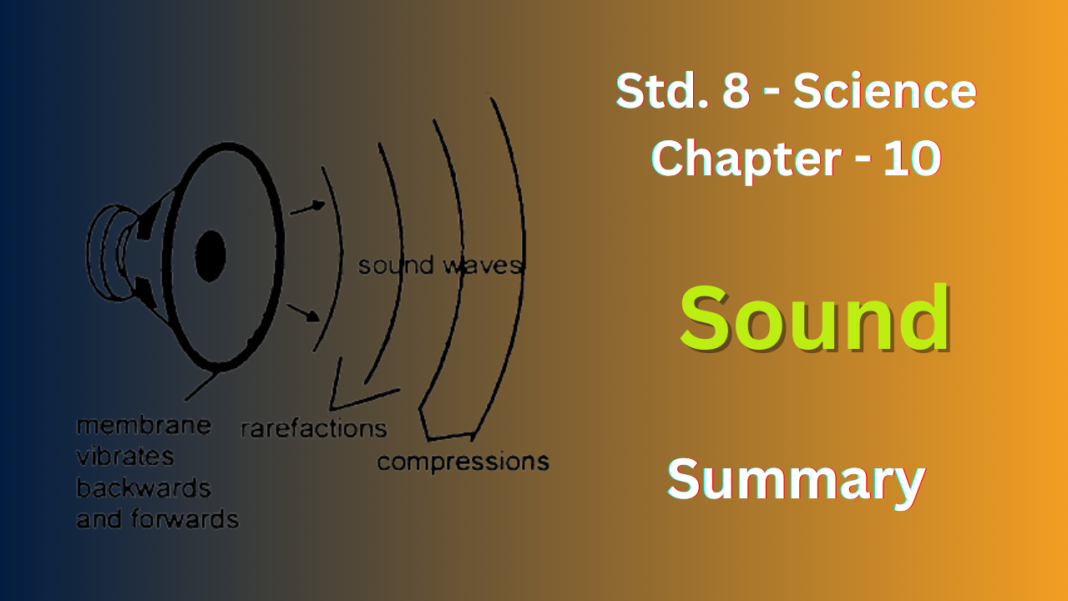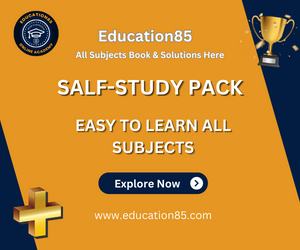NCERT Solutions for Class 8 Science Chapter 10
It dives into the fascinating world of how we hear and the science behind it. Here’s a quick breakdown of the key topics covered:
- Production: It all starts with vibrations! When objects vibrate, they create sound waves that travel through mediums like air or water.
- Waves: Imagine it traveling like ripples on a pond. It waves carry the vibration energy from the source to your ears.
- Hearing: Our amazing ears play a crucial role. The chapter explains how vibrations travel through the ear canal and make the eardrum vibrate. These vibrations are then converted into signals that our brain interprets as sound.
- Properties: Not all sounds are created equal! The chapter explores how factors like frequency (pitch), amplitude (loudness), and time period affect the way we perceive sound.
- Beyond the Audible Range: The world of sound is bigger than what we can hear! You’ll learn about sounds with frequencies too low or high for human ears to detect, like infrasound and ultrasound.
- Noise Pollution: Loud and unwanted sounds can be harmful. The chapter discusses noise pollution and its impact on our health and environment.
Question 1.
Choose the correct answer.
Sound can travel through
(a) gases only
(b) solids only
(c) liquids only
(d) solids, liquids, and gases
Ans: (d) solid, liquid and gases
Question 2.
Voice of which of the following is likely to have a minimum frequency?
(a) Baby girl
(b) Baby boy
(c) A man
(d) A woman
Ans: (c) A man
Q. 3 In the following statements, tick ‘T’ against those which are true and ‘F’ against those which are false.
1. Sound cannot travel in a vacuum.
Ans: True
2. The number of oscillations per second of a vibrating object is called its time period.
Ans: False
3. If the amplitude of vibration is large, the sound is feeble.
Ans: False
4. For human ears, the audible range is 20 Hz to 20,000 Hz.
Ans: True
5. The lower the frequency of vibration, the higher is the pitch.
Ans: False
6. Unwanted or unpleasant sound is termed as music.
Ans: False
7. Noise pollution may cause partial hearing impairment.
Ans: True
Q4. Fill in the blanks with suitable words.
1. Time taken by an object to complete one oscillation is called _______.
Ans: Time Period
2. Loudness is determined by the ________ of vibration.
Ans: Amplitude
3. The unit of frequency is ________
Ans: Heartz
4. Unwanted sound is called _______
Ans: Noise
5. The shrillness of a sound is determined by the ______ of vibration.
Ans: Frequency
Q5. A pendulum oscillates 40 times in 4 seconds. Find its time period and frequency.
Ans: The pendulum swings back and forth 10 times per second (frequency = 10 Hz). Each swing (one oscillation) takes 0.1 seconds (time period = 1/frequency).
Q6. he sound from a mosquito is produced when it vibrates its wings at an average rate of 500 vibrations per second. What is the time period of the vibration?
Ans: The time period of a mosquito wing vibration is 0.002 seconds.
We can find the time period using the formula:
Time period (T) = 1 / Frequency (f)
Here, the frequency (f) is 500 vibrations per second.
Therefore, T = 1 / 500 Hz = 0.002 seconds.
Q7. Identify the part which vibrates to produce sound in the following instruments.
1. Dholak
2. Sitar
3.Flute
Ans:
Dholak: Stretched membrane
Sitar: Strings
Flute: Air column inside the flute
Q8. What is the difference between noise and music? Can music become noise sometimes?
Ans: Noise is an unwanted or unpleasant sound, while music is pleasing and organised. Loud music, disliked music, or music played in the wrong setting can all become noise.
Q9. List the sources of noise pollution in your surroundings.
Ans: Since I am currently in Pune, Maharashtra, India, based on the information I have gathered here are some of the potential sources of noise pollution you might encounter in your surroundings:
- Traffic: Vehicular movement and honking are major contributors to noise pollution in Pune.
- Construction activities: Machinery used for construction can generate significant noise.
- Religious festivals: During festivals like Diwali, firecrackers can cause temporary spikes in noise levels.
- Loudspeakers: Public announcements or music played through loudspeakers can be noise sources.
Q10. Explain in what way noise pollution is harmful to humans
Ans: Noise pollution can harm humans in several ways:
- Hearing Loss: Constant exposure to loud noises (above 85 decibels) can damage the delicate hair cells in the inner ear, leading to hearing loss, which can be temporary or permanent.
- Health Problems: Loud noise can trigger the body’s stress response, increasing blood pressure, heart rate, and the risk of heart disease. It can also disrupt sleep patterns, leading to fatigue, irritability, and difficulty concentrating.
- Reduced Communication: Noise makes it harder to hear conversations and warnings, impacting communication and safety.
- Impact on Children: Children are more susceptible to noise-induced hearing loss and can experience learning difficulties due to noise disruptions in schools.
Q11. your parents are going to buy a house. They have been offered one on the roadside and another three lanes away from the roadside. Which house would you suggest your parents should buy? Explain your answer.
Ans: Suggest the house further from the road. It offers a quieter and healthier environment with less air pollution and is safer for children.
Q12. Sketch the larynx and explain its function in your own words.
Ans: The larynx, located in your throat, is like a mini voice box. It uses vocal cords to vibrate air and make sound (allowing you to speak!), and it acts like a valve controlling airflow between your lungs and mouth/nose.
Q13. Lightning and thunder take place in the sky at the same time and at the same distance from us. Lightning is seen earlier and thunder is heard later. Can you explain why?
Ans: Light travels much faster than sound. We see lightning first because of this speed difference, even though they happen at the same
FAQ’s
What topics are covered in NCERT Solutions for Class 8 Science Chapter 10 ?
Our solutions cover various aspects including its production, propagation, and reflection. We also delve into concepts such as frequency, wavelength, and the nature of sound waves.
How can I understand the properties of sound better with these solutions?
Our solutions provide clear explanations and examples to help you grasp the properties of sound effectively. You’ll learn about the factors affecting the speed of sound, the characteristics of different types of waves, and much more.
Are there any practical exercises included to reinforce learning about sound?
Yes, our solutions include practical exercises and activities that allow you to experiment with sound and observe its behavior firsthand. These hands-on activities enhance your understanding and make learning about sound more engaging.
How do these solutions help in preparing for exams?
Our solutions provide step-by-step answers to all questions in the NCERT textbook, ensuring thorough preparation for exams. By practicing with these solutions, you’ll become familiar with the types of questions asked and gain confidence in tackling them effectively.
Can these solutions be accessed online?
Yes, our NCERT Solutions for Class 8 Science Chapter 10 – are available online for free. You can access them anytime, anywhere, allowing for convenient and flexible study sessions.









